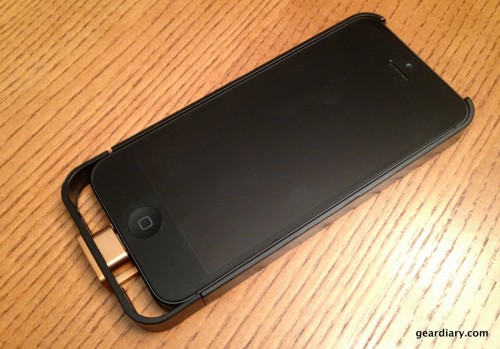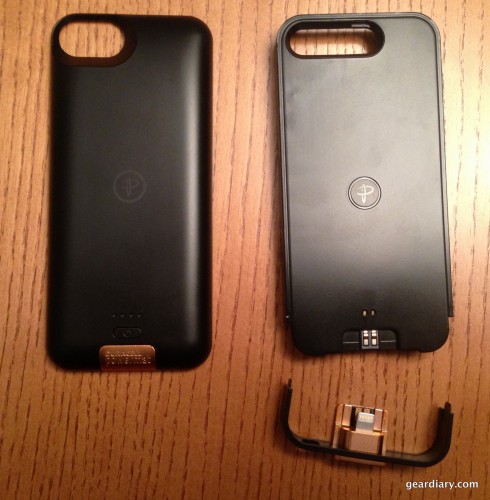 Ever since I learned about the magic of wireless charging back when the Palm Pre and Touchstone charging device came out, I’ve wanted to try it out for myself. Although the inductive charging experience with the Duracell Powermat isn’t perfect, it’s a pleasure to use. The Duracell Powermat retails for $49.99 and the Powermat PowerSnap Kit retails for $99.99.
Ever since I learned about the magic of wireless charging back when the Palm Pre and Touchstone charging device came out, I’ve wanted to try it out for myself. Although the inductive charging experience with the Duracell Powermat isn’t perfect, it’s a pleasure to use. The Duracell Powermat retails for $49.99 and the Powermat PowerSnap Kit retails for $99.99.
The version of the Powermat that I’ve been testing is able to wirelessly charge two devices at once. The Duracell Powermat uses induction charging technology that powers your gadget without having to plug your phone directly into a charging cable. However, the Powermat does not work on its own. In order to wirelessly charge your device, the device will need to either be built especially for wireless charging, or you’ll need to equip your device with a wireless charging kit that’s compatible with the Powermat.
The Duracell Powermat charges the iPhone at up to 1A, which is the same as the stock charging block that comes with the iPhone. The Powermat also stops charging your device when it’s full to prevent overcharging. The Powermat plugs into your wall outlet with a normal AC adapter.
Since the iPhone doesn’t have built-in inductive charging, I’ve had to use a wireless charging case; the wireless charging case that I’ve been testing along with the Powermat is the Duracell Powermat PowerSnap Kit. The kit comes with a slim iPhone 5/5s case called the AccessCase. The AccessCase is a two-piece case where the bottom piece allows access to your lightning port when you need it, yet allows you to wirelessly charge your phone when you set it down on the Powermat. The kit also comes with a battery pack called the SnapBattery that can clip onto the back of the AccessCase; it adds 1950mAh battery capacity to your iPhone. That’s more battery capacity than the iPhone 5 itself has.
The SnapBattery is able to wirelessly charge, but it is also able to be charged with a microUSB cable. The SnapBattery has LED indicators on the back as well as a power button. The LED indicators tell you how much juice is left, and the power button turns the battery power on and off. A great thing about the SnapBattery is that you’re able to charge both the battery and the iPhone if you place the phone on the Powermat while the SnapBattery is attached to the AccessCase. Since the Powermat has the capability to charge two devices, you could also charge the SnapBattery and your phone separately.
The Powermat and other compatible accessories all have magnets that hold the wireless device in place on the Powermat itself. This makes sure that the wireless charge gets transferred at the right location all the time. However, I’ve found in my testing that it’s usually not as easy as just dropping the phone onto the Powermat. I’ve found that I have to wiggle the phone around a little bit on the Powermat to find the right spot. You know you’ve found the right spot when the Powermat lights up and it gives a little alert sound. It’s not a deal breaker, but it’s definitely not as easy as advertised. The Powermat lights up on either side, depending on which side is currently charging. The light gets dimmer after 30 seconds, so it won’t keep you up at night. The Powermat also gives an alert sound when a device is removed from the charging station; this is a really nice touch that allows you to be sure you’ve put your device in the right place for charging.

The AccessCase on my iPhone. You can see how the bottom piece does not lay fully flush against the rest of the case. This bugged me.
My biggest complaint with the AccessCase is with the bottom piece that connects the induction charging element on the back of the case to your iPhone’s lightning connector. The piece is open to allow the sound from your speakers to pass through, however it makes for a bit of an awkward feel. I’m also afraid that my finger will catch on the opening in the case, and it’ll slip off of the case and I’ll drop my phone. The bottom piece also never seems to fit perfectly onto the rest of the case, and it clicks when you press on it from the bottom, making me think that it’s not on the right way. The bottom piece also has a hole that’s meant for headphones, however it will only work with a headphone jack that’s straight. Otherwise, you’ll have to take the bottom piece off to use headphones. The positive thing about the bottom piece is that it’s removable, which allows you to charge your phone with a lightning cable if you’re not nearby your Powermat. I just feel like the bottom piece could have been designed a little bit better for my taste.
Another concern I have with the Duracell AccessCase and SnapBattery is that they emit an extremely high-pitched whine when charging on the Powermat. I was able to get used to it after a week or so of testing, but others may have a more difficult time adjusting, especially at night. My wife even complained about the whine from across our king sized bed. It’s worth noting that the SnapBattery’s whine is noticeably louder than the AccessCase. This may not be an issue for our older readers, as you are supposed to lose the ability to hear the higher frequencies with age. (Have many of you noticed this to be true?)
Aside from my few complaints, I truly enjoy using the Powermat in conjunction with the AccessCase and SnapBattery. The AccessCase is slim, light, and unobtrusive, which are qualities I prefer in my iPhone cases. The SnapBattery provides sometimes much-needed additional battery capacity, while also having the ability to be wirelessly charged. It’s a truly convenient way to power your devices, and one can only hope that more gadget designers will eventually include induction charging in their devices in the future like Palm did with the unfortunately unpopular Pre, and as Nokia has more recently with some of their Lumia line.
The Powermat that is able to charge two devices at once can be purchased directly from Duracell for $49.99. The PowerSnap kit can be purchased directly from Duracell for $99.99.
MSRP: The Powermat for two devices is $49.99. The PowerSnap kit is $99.99.
What I Like: Induction charging is very convenient; Lights and sounds alert you when your device is charging; AccessCase is slim and light; The SnapBattery is also slim and easy to use.
What Needs Improvement: The bottom piece of the AccessCase could be better; The high-pitched whine takes getting used to; Placing your device on the Powermat to charge should be simpler without having to wiggle the device to find the perfect spot.
Source: Manufacturer supplied review sample





